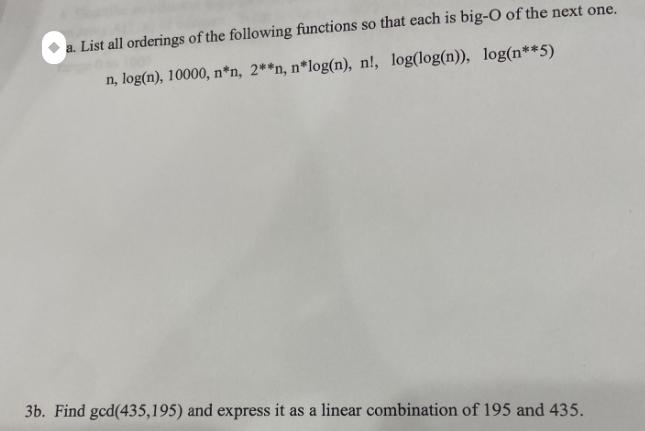Question
a. List all orderings of the following functions so that each is big-O of the next one. n, log(n), 10000, n*n, 2**n, n*log(n), n!,


a. List all orderings of the following functions so that each is big-O of the next one. n, log(n), 10000, n*n, 2**n, n*log(n), n!, log(log(n)), log(n**5) 3b. Find gcd(435,195) and express it as a linear combination of 195 and 435. 4. Describe an efficient algorithm to determine which integer appears the most times in an array A[1..n] of integers. What is the complexity of your algorithm in big-O notation? Would you use the same algorithm if it is known that the numbers in A are integers in the range 0 to 100?
Step by Step Solution
There are 3 Steps involved in it
Step: 1

Get Instant Access to Expert-Tailored Solutions
See step-by-step solutions with expert insights and AI powered tools for academic success
Step: 2

Step: 3

Ace Your Homework with AI
Get the answers you need in no time with our AI-driven, step-by-step assistance
Get StartedRecommended Textbook for
Discrete and Combinatorial Mathematics An Applied Introduction
Authors: Ralph P. Grimaldi
5th edition
201726343, 978-0201726343
Students also viewed these Mathematics questions
Question
Answered: 1 week ago
Question
Answered: 1 week ago
Question
Answered: 1 week ago
Question
Answered: 1 week ago
Question
Answered: 1 week ago
Question
Answered: 1 week ago
Question
Answered: 1 week ago
Question
Answered: 1 week ago
Question
Answered: 1 week ago
Question
Answered: 1 week ago
Question
Answered: 1 week ago
Question
Answered: 1 week ago
Question
Answered: 1 week ago
Question
Answered: 1 week ago
Question
Answered: 1 week ago
Question
Answered: 1 week ago
Question
Answered: 1 week ago
Question
Answered: 1 week ago
Question
Answered: 1 week ago
Question
Answered: 1 week ago
Question
Answered: 1 week ago
Question
Answered: 1 week ago
View Answer in SolutionInn App



